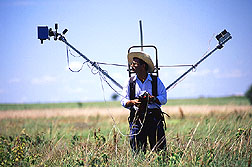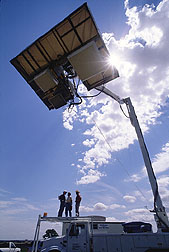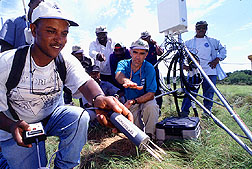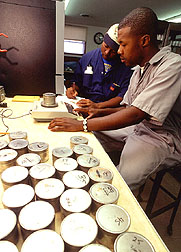World Weather: The Soil Has a Role Too
This past summer, two planes flew over Oklahoma into the border between wet and dry weather fronts. This atmospheric border zone spawns air turbulence that can affect local and, possibly, global weather. The boundary grows to more than a mile above ground during the heat of the day. At night, as land temperatures drop, it shrinks.
One of the two planes was a Twin Otter flown for the National Research Council of Canada; the other, a Long EZ experimental plane flown by the National Oceanic and Atmospheric Administration (NOAA). Both planes were part of an international fleet comprising 6 planes and 15 satellites, including the Russian Mir space station.
The fleet's mission: a joint USDA-NASA hydrology project called the Southern Great Plains 97 project (SGP97). Its purpose: to map soil moisture daily by airplane, using sensors that are prototypes for future satellites, with intermittent back-up from satellites. Together, the fleet mapped a 24-mile-wide rectangular path stretching 150 miles and bisecting the middle of Oklahoma, almost from its border with Texas right up to its border with Kansas. [More about the Southern Great Plains 97 project.]
"During droughts, the air gets very warm and dry over winter wheat fields that have been harvested and left bare," says ARS hydrologist Tom Jackson. "But air becomes cool and wet when it passes over irrigated fields, or over pasture or prairie grasses after a rain.
"This work," he adds, "should help us find out how large an area has to be in order to affect weather, producing a thunderstorm, for example. Knowing this, in turn, would help us make global climate change models more accurate, while at the same time helping farmers plan their irrigations."
|
|
Jackson is based at the Hydrology Laboratory run by USDA's Agricultural Research Service in Beltsville, Maryland. He was chief researcher for the entire SGP97 project.
The project, proposed by Jackson, was greatly expanded when NASA made it part of its climate-monitoring Mission to Planet Earth project.
"Ultimately, we want to be able to predict soil moisture anywhere in the world on any day of the year," says Jackson.
From June 18 to July 17 last summer, planes and satellites monitored how torrential rain and its rapid evaporation in 100oF heat affected air turbulence and weather, including tornadoes.
A Lockheed P-3B Orion flew in from NASA's Wallops Flight Facility in southern Maryland. With a soil microwave sensor in its bomb bay, the P-3B mapped soil moisture and temperature from 22,000 feet. It flew almost daily, passing over the entire study area between 9:30 and 11:30 in the morning.
Jackson says the P-3B also sent out laser beams to map a vertical profile of water vapor from plane to ground.
Other aircraft monitoring the area were the National Science Foundation's Cessna Citation based in North Dakota, a Piper Navaho Chieftain flown by the Ontario (Canada) Provincial Remote Sensing Office, and a U.S. Department of Energy (DOE) Cessna Citation.
|
|
DOE's Cessna, flown at 16,000 feet, carried a prototype of a thermal-infrared instrument that maps soil surface temperature. A Mission to Planet Earth satellite carrying this instrument will soon be launched.
The satellites included U.S. defense and NOAA weather satellites and radar and other satellites from Japan, Europe, and Canada.
On the ground, about 100 scientists and assistants from various countries scurried to coordinate ground measurements with the airplanes and satellites. Hazards abounded: bulls, brambles, heat, humidity, high winds, and critters that chewed electrical wires.
Jackson says the atmospheric boundary layer study made SGP97 unique compared to earlier studies—at Arizona's Walnut Gulch in 1990 and in southwestern Oklahoma's Little Washita River watershed in 1992.
"We're starting to better understand the interactions between this layer and the soil surface," Jackson says. "It looks like the scope and distance of their effect on climate could be broader and farther than we thought. They involve similar shifts in moisture and temperature seen in the ocean-atmosphere interaction with El Niño."
Everything on the ground was measured three ways: by airplane, satellite, and ground testing. Air—its turbulence, chemistry, temperature, and moisture—was measured from airplanes and on the ground.
Ground measurements are extremely accurate, but only for a small point on the land, Jackson says. "Airplanes cover large areas and help us bridge the gap by verifying extrapolations we make from ground points to the large areas typically observed by satellites."
The hydrology project built upon the earlier projects. It included the Little Washita again as one of three on-ground sampling sites, along with the ARS Grazinglands Research Laboratory at El Reno, Oklahoma, just above the Little Washita, and the DOE's Central Facility near the Kansas border. The three sites were used to verify the aerial information and were within the 3,600-square-mile aerial mapping path.
The Central Facility site sits in the middle of a 55,000-square-mile DOE meteorological study area that stretches from Oklahoma into central Kansas. The entire DOE area has been described as a weather station without walls. Its "floor" is more than 350,000 acres of grass- and wheatlands. DOE technicians launch at least nine weather balloons every day, on the hour, year-round. Only part of this area was mapped for this project.
Jackson says these sites were chosen for SGP97 because they have the most extensive networks of soil moisture sensors and meteorological instruments anywhere in the world.
Much of the land at the three sites is rangeland, a land-use type that covers at least 40 percent of the Earth's surface. This is why understanding what happens when widespread storms strike rangeland is important to making global predictions of everything—from weather to soil moisture to erosion to pesticide movement to flooding—Jackson says.
Jackson and his crew found what they were looking for on June 17, the day they arrived: a torrential downpour over most of the study area. They watched the P-3B fly every day, mapping the drying out of this zone. This pattern—alternating rain and drought—repeated itself several times throughout the study. The study ended with a dry-out period following a 6-inch downpour in the southern part of the flight path.
"The alternation between rain and drought is exactly what we needed," Jackson says.
Adios MIR, Adios ADEOS
While the weather, airplanes, and ground crews played their parts with near perfection, the researchers' orbiting "eyes" ran into problems. As the project began, the P-3B airplane and the Mir station passed over, capturing soil moisture data across both the mapping area and a wide swath of the United States. But a week later, on June 25, the researchers and an anxious world learned that a docking accident had severely damaged MIR, temporarily knocking out all power. While power for life support was quickly restored, it would be several months before power for experimental apparatus such as the soil microwave sensor would be available.
Compounding the problems for researchers, another satellite involved in the project—Japan's ADEOS satellite—spun out of control 10 days later and was lost in space forever.
Still, the P-3B plane, carrying two types of soil moisture microwave sensors, flew the flight path 22 out of 30 days. This was exactly what Jackson and his colleagues had planned for, knowing from experience that it is about as close to perfection as Nature and airplane logistics allow.
|
|
Meanwhile, Down Below
Students and faculty from Alabama A&M University's NASA-sponsored remote-sensing center helped gather data. The University benefits from being in Normal, Alabama, near NASA's Marshall Space Flight Center in Huntsville. A&M University students joined graduate students from around the country in making ground measurements on government rangeland. Other ARS participants included the Grazinglands Research lab at El Reno, the Soil Tilth Laboratory at Ames, Iowa, and the Salinity Laboratory at Riverside, California.
At the El Reno site, Jackson's Beltsville colleague, hydrologist Bill Kustas, supervised measurement of meteorological conditions at four locations. At each site, 10-foot towers supported sophisticated instrumentation for measuring air turbulence at ground level. One tower was toppled by extreme wind gusts and had to be repaired.
Kustas kept an eye on weather reports. He often brought his crew out at 5 a.m. to beat a storm, download the previous day's data, and put protective bags over sensitive instruments to protect them from hail and blowing debris.
The P-3B aircraft unfurled from its bomb bay an experimental soil-moisture sensor—a bundle of antennae "sticks" called ESTAR, for Electronically Scanned Thinned Array Microwave Radiometer.
"The antennae receive natural microwave emissions from the soil. The weaker the emission, the more the soil moisture," Jackson explains. Together, the sticks, each about 3 feet long, did the work of what would otherwise have been a large, heavy antenna. "The ESTAR sensors were the core of the experiments, and they worked," he says.
ESTAR uses a microwave band frequency that is more suitable for measuring soil moisture," says Jackson. "A preliminary review of the data shows a remarkable match between air and ground data, convincing me beyond a shadow of a doubt that the data will be useful."
NASA is considering using ESTAR on satellites, possibly making a decision as early as this year. It is an alternative to the AMSR, or Advanced Microwave Scanning Radiometer, which is similar to the sensors tested aboard Mir and the radar satellites. The AMSR will be used by a NASA satellite planned for launch in 2000 and by the Japanese ADEOS II, also planned for launch in 2000.
By around 11 o'clock each night, Jackson's NASA colleague Ann Hsu had posted the day's data on the World Wide Web site created by the Hydrology Laboratory for the experiment. This site allowed Jackson to communicate with participants in the experiment—even before they arrived from around the world.
Website Open to All
Once the experiment began, the entire team—on site at various locations in Oklahoma—used the web to review the data each night and make plans for the next day.
Jackson says that one of the ways the SGP97 project differed from the smaller, earlier tests at Walnut Gulch and Little Washita was the dramatic increase in e-mail and World Wide Web use.
In fact, anyone can view various aspects of the experiment on that website, including preliminary data prepared for the public. (Go to http://hydrolab.arsusda.gov/sgp97) The experiment's results will be presented at the American Geophysical Union meeting during May 1998. Researchers will publicly share all data in September on a to-be-announced NASA web site.
This past December, Jackson learned that the Mir space station had resumed collecting data over Oklahoma. He won't need to go to Oklahoma this June to verify the data. He's glad that with last summer's work, scientists around the world will be able to process satellite data for years to come—without crawling on their hands and knees with buckets and soil spatulas.—By Don Comis, Agricultural Research Service Information Staff, 6303 Ivy Lane, Greenbelt, Maryland 20770, phone (301) 344-2748.
Thomas J. Jackson and William P. Kustas are at the USDA-ARS Hydrology Laboratory, Bldg. 007, 10300 Baltimore Ave., Beltsville, MD 20705-2350; phone (301) 504-8511, fax (301) 504-8931.
"World Weather: The Soil Has a Role Too" was published in the April 1998 issue of Agricultural Research magazine. Click here to see this issue's table of contents.











